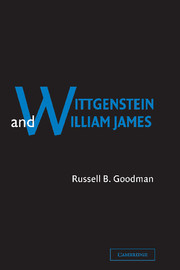Book contents
- Frontmatter
- Contents
- Preface
- Abbreviations
- Introduction
- 1 Varieties of Pragmatic Experience
- 2 Wittgenstein and The Varieties of Religious Experience
- 3 Wittgenstein and The Principles of Psychology: An Introduction
- 4 What Is It Like to Be a Human Being?
- 5 Language and Meaning
- 6 Pragmatism Reconsidered
- Coda
- Notes
- Index
3 - Wittgenstein and The Principles of Psychology: An Introduction
Published online by Cambridge University Press: 23 July 2009
- Frontmatter
- Contents
- Preface
- Abbreviations
- Introduction
- 1 Varieties of Pragmatic Experience
- 2 Wittgenstein and The Varieties of Religious Experience
- 3 Wittgenstein and The Principles of Psychology: An Introduction
- 4 What Is It Like to Be a Human Being?
- 5 Language and Meaning
- 6 Pragmatism Reconsidered
- Coda
- Notes
- Index
Summary
Wittgenstein recommended James's Varieties Drury as a good work of philosophy in 1930, just about the time James's name begins to turn up in his notebooks. Yet it is the James of The Principles of Psychology who appears there, not the James of Varieties or Pragmatism. The typescript published as Philosophical Grammar, for example (composed in 1932–4), mentions William James in a context that indicates the source clearly:
A man who reads a sentence in a familiar language experiences the different parts of speech in quite different ways. … We quite forget that the written and spoken words “not,” “table,” and “green” are similar to each other. It is only in a foreign language that we see clearly the uniformity of words. (Compare William James on the feelings that correspond to words like “not,” “but,” and so on.)
Wittgenstein's source is a passage from James's chapter on “The Stream of Thought” in The Principles of Psychology: “We ought to say a feeling of and, a feeling of if, a feeling of but, and a feeling of by, quite as readily as we say a feeling of blue or a feeling of cold (PP, 238). Although Wittgenstein had by this time already come to hold that “the use of a word in the language is its meaning,” and would later criticize James for confusing experiences of meaning with the meaning itself, he does not do so here. Here, he works with James.
- Type
- Chapter
- Information
- Wittgenstein and William James , pp. 60 - 88Publisher: Cambridge University PressPrint publication year: 2002



